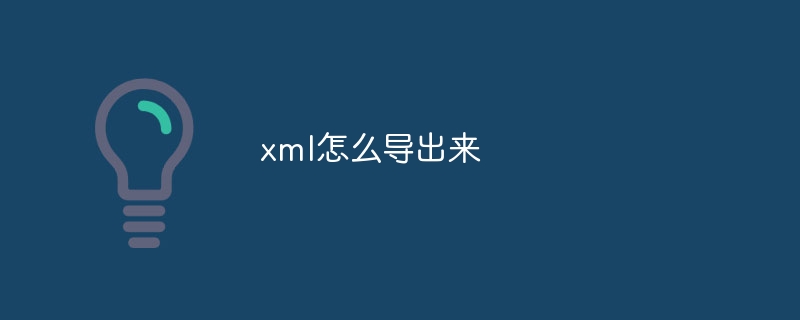Methods to export XML files: DOM: Use the document object model to create an XML document object representation and extract data. SAX: parses XML documents through event-driven methods, defines handlers to process events and store data. JAXB: Use Java objects to map XML data model to group Java objects. XSLT: Use the extensible stylesheet language to convert XML documents to other formats and use the XSLT processor to apply conversion rules. Third-party libraries: Use third-party libraries such as dom4j, jdom, xmlbeans to implement XML processing and simplify the export process.

XML export method
XML (Extensible Markup Language) is a common format used to represent and store data. Exporting it to another system or application can be useful. Here are several ways to export XML files:
DOM (Document Object Model)
- Use the DOM parser to create an object representation of an XML document.
- Iterate through the document structure and extract the required nodes and data.
- Create an XML document to store the extracted data.
SAX (Simple API for XML)
- Parses XML documents through event-driven methods.
- Define content handlers to handle different XML events (such as element start/end).
- Create an XML document to store parsed events.
JAXB (Java architecture binding)
- Map Java objects with XML data models using the JAXB Application Programming Interface (API).
- Use
JAXBContextandMarshallerobjects to marshalle objects to XML.
XSLT (Extensible Stylesheet Language Conversion)
- Use XSLT to convert an XML document to another format, such as HTML or XML.
- Create an XSLT stylesheet to specify the conversion rules.
- Use the XSLT processor to apply the stylesheet and generate a new XML file.
Third-party library
- Using third-party libraries (for example: dom4j, jdom, xmlbeans), these libraries provide high-level XML processing capabilities.
- These libraries generally provide methods and tools to simplify the XML export process.
The above is the detailed content of How to export xml. For more information, please follow other related articles on the PHP Chinese website!

Hot AI Tools

Undress AI Tool
Undress images for free

Undresser.AI Undress
AI-powered app for creating realistic nude photos

AI Clothes Remover
Online AI tool for removing clothes from photos.

Clothoff.io
AI clothes remover

Video Face Swap
Swap faces in any video effortlessly with our completely free AI face swap tool!

Hot Article

Hot Tools

Notepad++7.3.1
Easy-to-use and free code editor

SublimeText3 Chinese version
Chinese version, very easy to use

Zend Studio 13.0.1
Powerful PHP integrated development environment

Dreamweaver CS6
Visual web development tools

SublimeText3 Mac version
God-level code editing software (SublimeText3)

Hot Topics
 XML Namespace: Coding Guide
Jun 20, 2025 am 12:09 AM
XML Namespace: Coding Guide
Jun 20, 2025 am 12:09 AM
The coding guide for XML namespaces includes: 1. Declare the namespace using the xmlns attribute, such as. 2. Use prefix to refer to the namespace, such as. 3. The namespace URI is a unique identifier, not a real URL. 4. When using the default namespace, all unprefixed elements belong to the namespace, such as. 5. Use tools such as XSD to verify and debug namespaces. 6. Maintain prefix consistency and document readability and provide necessary comments.
 XML rules: Common errors to avoid
Jun 22, 2025 am 12:09 AM
XML rules: Common errors to avoid
Jun 22, 2025 am 12:09 AM
Methods to avoid XML errors include: 1. Ensure that the elements are nested correctly, 2. Escape special characters. Correct nesting avoids parsing errors, while escape characters prevent document corruption, using an XML editor can help maintain structural integrity.
 XML: Are Namespaces required?
Jul 01, 2025 am 12:05 AM
XML: Are Namespaces required?
Jul 01, 2025 am 12:05 AM
XMLnamespacesarenotalwaysrequired,buttheyareessentialincertainsituations.1)TheyhelppreventnameconflictsinXMLdocumentscombiningelementsfrommultiplesources.2)Theycanbeomittedinsmall,self-containeddocuments.3)Bestpracticesincludeusingmeaningfulprefixesa
 XML well formed vs Valid: A full comparison
Jun 21, 2025 am 12:07 AM
XML well formed vs Valid: A full comparison
Jun 21, 2025 am 12:07 AM
XML is called "well-formed" to refer to its basic syntax correctness, while "valid" requires it not only well-formed, but also to conform to a specific pattern or DTD. 1. Well-formedXML needs to follow XML specifications, such as correct nesting of elements and correct use of tags. 2. ValidXML must comply with the structure and content rules defined by the schema or DTD.
 XML Namespace: The most common Errors
Jun 27, 2025 am 01:00 AM
XML Namespace: The most common Errors
Jun 27, 2025 am 01:00 AM
XMLnamespacescancauseerrors,butthesecanberesolvedbyfollowingspecificsteps.1)Alwaysdeclarethenamespaceusingxmlnsattherootorwhereneeded.2)Ensureprefixesmatchthedeclarednamespaces.3)Useuniqueprefixesfordifferentnamespacestoavoidconflicts.4)Properlydecla
 XML: Which are the best alternatives?
Jul 01, 2025 am 12:12 AM
XML: Which are the best alternatives?
Jul 01, 2025 am 12:12 AM
JSON,YAML,ProtocolBuffers,CSV,andTOMLaresuitablealternativestoXML.1)JSONisidealforreadabilityandeaseofuse.2)YAMLofferscleanersyntaxandsupportscomments.3)ProtocolBuffersexcelinhigh-performanceapplications.4)CSVisperfectforsimpledataexchange.5)TOMLbala
 Why XML Is Still Relevant: Exploring Its Strengths for Data Exchange
Jul 05, 2025 am 12:17 AM
Why XML Is Still Relevant: Exploring Its Strengths for Data Exchange
Jul 05, 2025 am 12:17 AM
XMLremainsrelevantduetoitsstructuredandself-describingnature.Itexcelsinindustriesrequiringprecisionandclarity,supportscustomtagsandschemas,andintegratesdatavianamespaces,thoughitcanbeverboseandresource-intensive.
 XML Basic Rules: Ensuring Well-Formed and Valid XML
Jul 06, 2025 am 12:59 AM
XML Basic Rules: Ensuring Well-Formed and Valid XML
Jul 06, 2025 am 12:59 AM
XMLmustbewell-formedandvalid:1)Well-formedXMLfollowsbasicsyntacticruleslikeproperlynestedandclosedtags.2)ValidXMLadherestospecificrulesdefinedbyDTDsorXMLSchema,ensuringdataintegrityandconsistencyacrossapplications.






